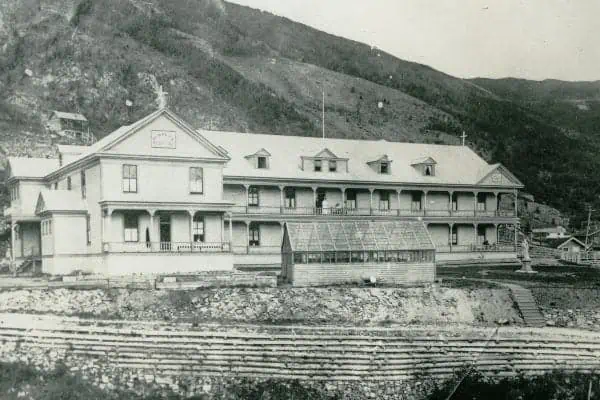When James Domville Richards joined the Klondike Gold Rush, the Yukon became blessed with one of its most endearing characters.
The quiet, reserved man – who became known as Buzzsaw Jimmy – encountered disaster time and time again. Working as a woodcutter for over 50 years, he survived a train derailment, acquired over a metre of stitches all over his body, lost a finger and, most famously, managed to lose the same leg twice.
Jimmy almost didn’t make it to the territory. He left his home in New Brunswick at the height of the gold rush in 1898 and his journey west and north was an eventful one.
His train derailed while he was crossing the prairies, resulting in the deaths of two of his fellow passengers. Then, the backup train went off the rails in Canmore, Alberta, a mountain town and dangerous place for this sort of thing to happen.
Miraculously, Jimmy survived this railway nightmare. However, as he continued to the gold fields, the little steamship he was travelling on up to the Alaskan coast become severely damaged and nearly came apart completely in the rough waters of the Pacific Ocean.
Like so many disappointed stampeders at the height of the Rush, Jimmy made it all the way to Dawson City only to discover all of the best land was claimed and there was little opportunity to strike it rich.
Undeterred, he changed career paths in mid-stride and began work as a woodcutter that would eventually turn Buzzsaw Jimmy into a Yukon legend.
After several years of working up and down the Yukon River performing odd jobs and earning a hard living, Jimmy made Whitehorse his permanent home. He opened a sawmill in 1910, but quickly discovered that it was not financially viable and was forced to shut it down shortly thereafter.
Jimmy’s ingenious answer to his financial woes was the invention of a mobile woodcutting machine. He pieced his machine together from parts harvested from a Model T Ford, an old tractor, and whatever bits of iron and circular blades he could get his hands on.
This elaborate contraption turned out to be the speediest and most effective method of cutting wood in the territory. Buzzsaw Jimmy could cut eight to ten cords per hour with this thing, and could wheel it about from place to place, cutting wood right on his customer’s own property.
The next best machine in town was plugging along at three cords per hour – Jimmy had the competition eating his dust.
Brilliant inventions aren’t always the safest things in the world. Buzzsaw Jimmy learned this the hard way a few times.
In September 1911, he nearly lost his right arm in a sawing accident, but refused to stay in the hospital for longer than one day. Between 1915 and 1917, he fell from the seat of his woodcutter, got his leg caught in the gears and needed to have his leg amputated above the knee. It seems his ability to face certain disaster and emerge unscathed had deserted him.
Jimmy came out of this disaster with a wooden leg, but that didn’t stop him. As soon as he was physically able, he was working with the machine and cutting wood again.
A whole series of accidents followed, including a 45-inch (114 cm) cut to his back, a fresh injury to the remaining part of his right leg, and smaller cuts all over his body.
Eventually the man ran out of body parts to injure. Buzzsaw Jimmy’s most famous accident happened when he tumbled out of his seat again and the machine’s blade cut his leg in half.
Mercifully, it was the same leg he’d already lost. His peg leg was cut in two, prompting the man to tell Fate, “I fooled you that time, you son of a bitch!”
Buzzsaw Jimmy was a fixture around Whitehorse. In addition to the work he did as a woodcutter and the amusing stories that his efforts provided the community, he caught the attention of many a tourist passing through town, and appeared in Jim Robb’s portrait collection, The Colourful Five Per Cent.
In 1950, Jimmy was in his 70s and the machine was retired and moved onto a friend’s property. Buzzsaw Jimmy stayed in Whitehorse until 1963, then moved south to Vancouver, where he died in 1967.
Sadly, his unique device ended its life at a dump in Whitehorse. It would have made an excellent contribution to any museum collection in the Yukon, had it been preserved.




